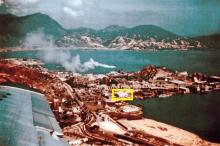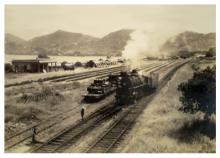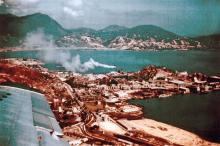Current condition
Demolished / No longer exists
Date completed
Date closed / demolished
Dates and location approximate for now. [Outline added, based on the map 1960.1 Hong Kong.]
The camp appears in photos of the area from the 1940s on. IDJ writes:
That whole area was covered with Nissen Huts and military playing fields up until at least the 1970s and probably until about the time the first Cross Harbour Tunnel was built.



Comments
Camp Kowloon
Peter Binstead mentions this camp:
I joined the Regt in July 1959 but remained in HK after it left in '60. I was posted to Camp Kowloon in Chatham Road and served out my remaining 2yrs. there.
Re: Camp Kowloon
I think there is a small mention in Gweilo of Martin Booth and family having checked into the Grand Hotel of proceeding to the Camp near the railway tracks for a meal.
Booth at Camp Kowloon
Moddsey, well spotted. It isn't named, but it certainly matches the description. The Grand Hotel was a short distance away on Carnarvon Road. After dropping off their cases at the hotel, they went back out to the dark blue saloon car they'd arrived in.
[It] drove through a gateway guarded by two army sentries and pulled up in front of a large, long Nissen hut with very un-military gingham curtains hanging in the windows.
They ate lunch, then:
At the end of the meal, which was punctuated by steam locomotives periodically hauling trains along a railway track not thrity feet from the Nissen hut, the officer shook my hand.
Chatham Road Camp
Here are the results of a couple of searches through Google. It certainly had a wide variety of occupants, including refugees, cholera cases, sea-cadets, soldiers and triads!
erected for the accommodation of a possible influx of refugees from Shanghai was taken over by the Military Authorities, there has been no spare accommodation which can be used in the event of an emergency arising. Since the re-occupation, the need for some sort of transient camp has been repeatedly felt. Up to the present, we have been fortunate in always being able to find some make-shift solution, but it is considered that this unsatisfactory position has continued long enough. It has therefore been decided to construct a further camp in the Chatham Road area, and a sum of $1,600,000 has been included for this. Legco minutes.
When symptoms of cholera infection in contacts began to appear, they were immediately taken to Lai Chi kok Infectious Disease Hospital. The Chatham Road Quarantine Centre was eventually closed on 17 September. Plague, SARS and the story of medicine in Hong Kong.
Undated:
Chatham Road Camp
On this site was the Golden Dragon Club. This was an all ranks club for the army in HK and managed in the 1960's by Mr.Chan. When the site closed down, the club was re-located to Gun Club Barracks